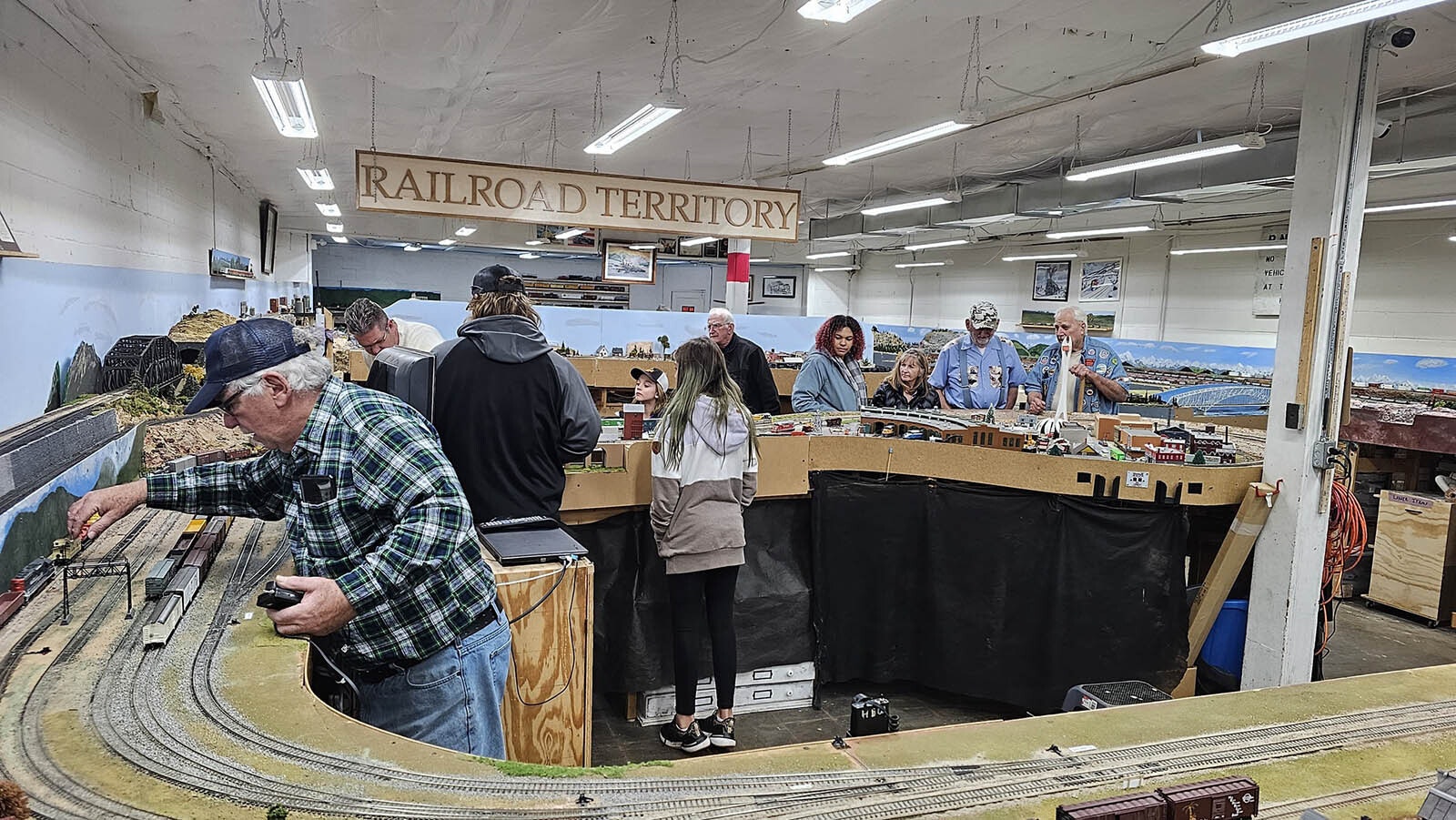CASPER — It’s almost an out-of-body experience walking through the doors at the local model railroad club. Like gods in their own little universes, these model railroaders are building worlds, including an impressively detailed recreation of Casper.
There’s the iconic Wells Fargo onion building and egg-beater spire, the railyard and other historically accurate neighborhoods. And a tour over a trestle bridge to an miniature Wyoming mining district featuring the fictional “Miss Teek Mine.”
Two locomotives pulling 25 cars with the last’s end-of-train light blinking chug along a wall on an N-gauge track. In the middle of the room a woman paints a backdrop, in the back a man works on revising a track layout.
The Central Wyoming Model Railroad Association is doing more than just playing with their toys. They’re part of a model railroad culture that cranks their childhood fascination with railroading to 11. Now adults, they spend Saturday afternoons completely involved with the tiny worlds that are meticulous to the last detail — and all to scale, at various levels.
From the locomotive (engine) to the clown wagon (caboose), and all the cars between them, model railroaders go far beyond living in their own fantasy worlds. They use nostalgia to honor their own childhoods and the American legacy of railroads. And while some may accuse model railroaders of just playing with toys, it’s nothing like that.
“We’re here to promote model railroading, not your train wrapped around the Christmas tree,” said Harry Buhler, treasurer for the 17-member club. “We’re here to show people that there is a lot more to it than just the Christmas tree. You can build scenes of different areas of the country if you want. You can use your imagination to do something. … And we teach people how to do things, how to do the scenery, how to do the wiring and how to do the track laying. We’re basically information.”
1987 Beginning
This particular Casper club has been around since 1987, when the club’s unofficial historian and only remaining original member Homer Whitlock said a hobby store owner in town called a meeting and suggested forming a club. That led to making train layouts to displays at the mall and other places, and eventually to the group acquiring its clubhouse in 1999 on North Center Street.
Inside the clubhouse is a model railroading mecca with multiple layouts for club members and visitors to explore the world of N, HO, S and O-gauge model railroading. The letters represent the different scale sizes of the locomotives and rail cars. The O-gauge that many Baby Boomers received in the form of a Lionel train set at Christmas is a 1:48 scale replica.
HO and N are smaller — HO representing half the size of the O-gauge system.
Buhler said there is a little give-and-take when model railroaders debate the best scale size, but mostly it boils down to how much space someone has for a layout.
Members at the clubhouse on a recent Saturday when Cowboy State Daily visited said they joined for different reasons.
Buhler said he was looking for something to do on Thursday and Friday nights about 18 years ago when he moved to the city. He enjoys building layouts, installing electrical components for track and fixing whatever breaks.

Winter Draw
Scott Bergey, a 24-year veteran, wanted to find something to do during Wyoming’s cold, windy winters. He said model railroading allows for a lot of creativity and the club offers a lot of expertise in different areas of the hobby.
Bergey tried building his own rail cars to duplicate the first train in Casper — the Freemont, Elkhorn and Missouri Valley Railroad.
“Those (model) cars don’t exist,” he said. “So, I kind of had to build some and modify some to give my best guess of what the train looked like when it came into Casper.”
When he first joined the club, the meeting place was called “plywood central” because trains were run on plywood with very little scenery.
“We have (since) improved the clubhouse and the layouts a lot,” Bergey said.
Former realtor Larry Heintzman encountered the club five years ago. He sought the help with a special model train project that his real estate office was trying to arrange around a Christmas-tree display one holiday season. Club members were happy to help. So, Heintzman bought 20 raffle tickets for a model train set from Menards the group was offering for a holiday fundraiser. He won.
“That’s what got me into the club,” he said. “I really like the DCC (digital command control) stuff.”
Digital Controls
Controlling the trains is different from the early days when a transformer was wired to a track and then plugged into a wall. The trains were operated through the amount of electricity applied to the train tracks from the transformer and conducted through the engine’s wheels.
Now, each engine has its own computer chip with an associated number. That specific number is programmed into a digital controller to give the “engineer” specific throttle power to move that individual locomotive around the electrified track.
While none of the layouts are exact replicas of a city or region, the club’s trains rumble through mountain tunnels, across painted bays over hand-built bridges, and on the HO-scale layout into a freight yard and city that familiar Casper scene that also has the iconic Rialto Theater.
Buhler said the Casper buildings were built by a former member using computer-assisted design. He also designed a couple plastic metal-girder style bridges. And there is also an old-fashioned timber bridge hand-glued by Buhler that crosses a gulch. It took him about a month to put it together.
“I like to build things, and that is it,” he said.
Sharing The Throttle
While most model railroading clubs don’t allow nonmembers to run the trains, Buhler said the Casper group does.
“We give them a throttle and show them how to run it and let them run around the layout,” he said. “I don’t know of anybody else that does that. We control the speed of the train so they can’t wreck anything.”
Historian Whitlock points to locomotives on the group’s layouts. He said the club only uses model engines that existed.
“All of these are replicas of some actual locomotive,” Whitlock said. “We don’t have a kitbashed locomotive on the layout. Kitbashed is something that is a figment of your imagination.”
Kitbashing refers to using parts of different model kits to create a unique new model.
Whitlock said his imagination for model railroading was fired up by watching real trains at the Bingham Canyon copper mine as he grew up in Utah. He points to a model train car with a crane as he launches his story.
As a young boy he was down by the tracks sitting on a pile of railroad ties watching the action and playing with a pocketknife, he said. The knife fell between the ties and he couldn’t move them.
A few days later, he skipped school and went back to the ties to try and find a solution to his dilemma. A rail repair crew with a little clamshell crane stopped alongside the pile. An operator asked what he was doing. He explained his situation and they proceeded to use the crane to unpack the ties until he could find his knife.
“It was quite a place to visit, especially for a young guy,” he said.
Hobby Costs
Costs to get into model railroading vary. Starter trains and track can be found for as little as $150 for an HO starter set, to nearly $2,000 for specific hobbyist replica train sets. Buhler said some steam engines go for $5,000 — and include all the bells and whistles.
But don’t necessarily expect to get that investment back. The going rate for anyone selling a collection now will get them about 10 cents on the dollar, Buhler estimated.
The club owns all the layouts at its building, but members own the trains.
Each December, the group takes its trains and layouts to the National Historic Trails Center in Casper to others enjoy some hands-on experiences with model railroading.
Visitors are welcome to check out the group’s layouts and run the trains from 7-10 p.m. Fridays and noon to 4 p.m. Saturdays at 1356 N. Center St. in Casper.
Buhler said the biggest challenge the club faces is attracting new and younger members to the group.
“Most of the railroad clubs have a lot of older members. I think the problem is video games for one and the instant gratification you get from a video game,” he said. “This takes a little while to put together. … It only goes round and round and round, and it’s limiting — until you get into it.”

Dale Killingbeck can be reached at dale@cowboystatedaily.com.















